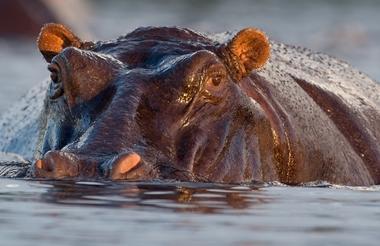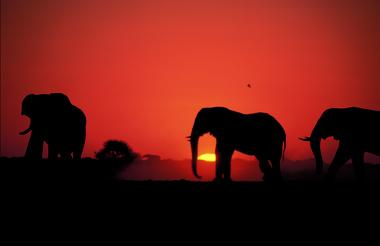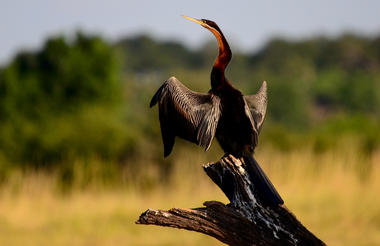At Victoria Falls, the earth splits open and swallows one of Africa’s greatest rivers, the mighty Zambezi, creating the largest sheet of falling water on earth. As the water hits the narrow depths of the Batoka Gorge beneath, it blasts a cloud of mist skywards, lending the falls their local name ‘mosi-oa-tunya’ (the smoke that thunders). When the Zambezi is at its fullest, the mist hangs a permanent raincloud above the falls, showering visitors on even the sunniest of days and visible for miles around.
Above the falls on the upper Zambezi, boats cruise the tranquil water at sunset while the distant spray catches the fading light downstream. Below the falls, the Batoka Gorge’s rocky walls funnel the lower Zambezi into a chain of world-class rapids, prime for white water rafting.
Aside from being a UNESCO world heritage site and a natural world wonder, Victoria Falls also forms a natural border between Zimbabwe and Zambia. The falls can be seen from both countries, and for the most part the same activities are offered on both sides, from helicopter scenic flights to village visits and souvenir shopping.
Whether your idea of getting away from it all is a relaxed high tea in colonial grandeur or a heart-stopping bungee jump off a bridge, Victoria Falls keeps both the faint of heart and the most insatiable of adrenalin junkies busy for days.
From Zambia, a side on view of the falls is on offer with views into the Batoka Gorge, as well as the possibility of perching yourself at the edge of the falls on the vertigo-inducing Livingstone Island.
From Zimbabwe, you’ll get a full-frontal view of three quarters of the falls’ 1.7km wide curtain of water from viewpoints and footpaths meandering through a rainforest kept hot and humid by the spray of the falls.
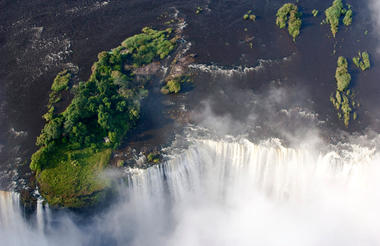

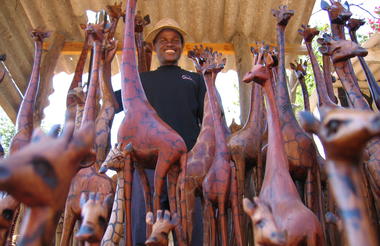
At Victoria Falls, the earth splits open and swallows one of Africa’s greatest rivers, the mighty Zambezi, creating the largest sheet of falling water on earth. As the water hits the narrow depths of the Batoka Gorge beneath, it blasts a cloud of mist skywards, lending the falls their local name ‘mosi-oa-tunya’ (the smoke that thunders). When the Zambezi is its fullest, the mist hangs a permanent raincloud above the falls, showering visitors on even the sunniest of days and visible for miles around.
Above the falls on the upper Zambezi, boats cruise the tranquil water at sunset while the distant spray catches the fading light downstream. Below the falls, the Batoka Gorge’s rocky walls funnel the lower Zambezi into a chain of world-class rapids, prime for white water rafting.
Aside from being a UNESCO world heritage site and a natural world wonder, Victoria Falls also forms a natural border between Zimbabwe and Zambia. The falls can be seen from both countries, and for the most part the same activities are offered on both sides, from helicopter scenic flights to village visits and souvenir shopping.
Whether your idea of getting away from it all is a relaxed high tea in colonial grandeur or a heart-stopping bungee jump off a bridge, Victoria Falls keeps both the faint of heart and the most insatiable of adrenalin junkies busy for days.
From Zambia, a side on view of the falls is on offer with views into the Batoka Gorge, as well as the possibility of perching yourself at the edge of the falls on the vertigo-inducing Livingstone Island.
From Zimbabwe, you’ll get a full-frontal view of three quarters of the falls’ 1.7km wide curtain of water from viewpoints and footpaths meandering through a rainforest kept hot and humid by the spray of the falls.
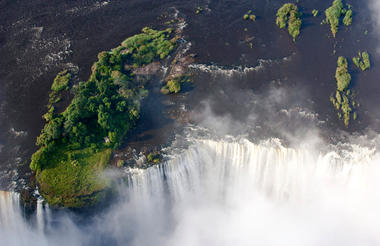
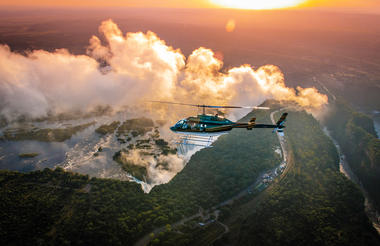
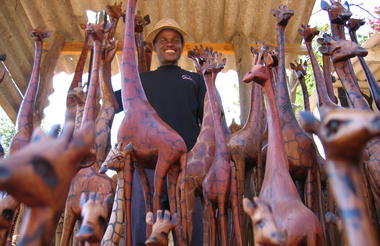
If you have dreamt of an Africa with expansive plains and wide horizons, where elephant and buffalo traipse in huge numbers towards waterholes and giraffe browse from flat topped acacias while a blazing sun sets behind them… you can find it in Hwange.
As Zimbabwe’s largest national park, Hwange has a sizeable reputation that it wholeheartedly deserves.
The sight of hundreds, if not thousands of elephants and buffalos streaming towards you as you sit at a waterhole is indescribable. There is nothing like the sound of elephants' peaceful rumbling or the deep thundering of buffalo hooves on hard ground when they spook, wary of lions that may lie in wait.
This sight and sound of a waterhole in the midst of pristine wilderness visited by huge numbers of animals is typical of Hwange. Beyond the sights and sounds, the feeling of Hwange is what will remain with you: awe and peace from spending time in a true, preserved wilderness.
Hwange’s diverse habitats mean that it offers large numbers of desert adapted, plains and woodland animals. The famed elephant population is one of the largest in the world and it has plentiful predator populations such as lion, leopard and cheetah. Hwange also boasts one of Africa’s last strongholds of endangered African wild dogs.
Hwange offers the opportunity to see a variety of rare antelope such as eland, sable, roan and if you are lucky the desert-adapted oryx (gemsbok).
Apart from the variety of species and its beautiful setting, Hwange is unique in its ease of access. The park begins a mere hour from Victoria Falls and there is a range of accommodation across every price point. The North typically offers a mix of private lodging and National Park chalets, as well as a well-maintained road network. Hwange’s more southern concessions are generally private, offering luxury lodges and camps.
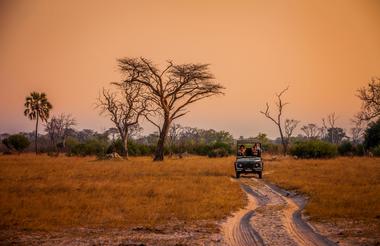
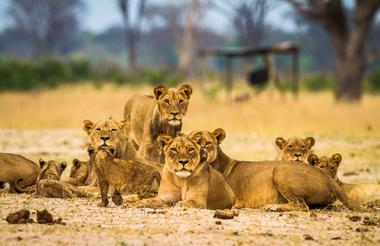

As previously described


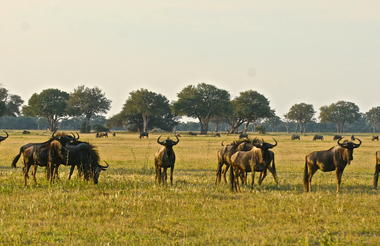
Situated in the Chobe region of Botswana and bordering the renowned Hwange National Park in Zimbabwe, the pristine Kazuma Forest Reserve offers visitors a quiet and more remote bush experience. This impressive landscape stretches over thousands of hectares and features expansive grassland, natural pans and Mopane tree forests. It is home to abundant wildlife and provides an ideal habitat for wildebeest, buffalo, antelope, sable, giraffe, zebra, lion and leopard. Numerous herds of elephants also frequent this reserve due to its location adjacent to Hwange and the area is considered an important elephant corridor. The nearby Kazuma Pans attract many birds making it a bird watching paradise boasting over 380 different species. Visitors can enjoy a variety of activities including: guided walks, fishing trips and sunrise or sunset game drives.
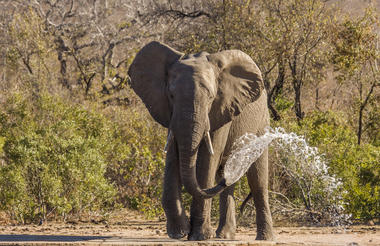
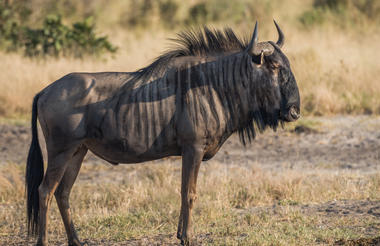

The Chobe Riverfront is an elephant mecca; home to the largest density of African elephants in the world. Travel here during winter and you’ll fast run out of fingers and toes while you count them drinking at the riverbanks and socialising out on the floodplains.
Thanks to its ease of access from Victoria Falls, the Chobe Riverfront is the busiest part of Botswana (though still a much quieter affair than most South or East African safaris). What Chobe lacks in solitude during the busier months, it more than makes up for with quality game viewing.
Chobe will leave you feeling tiny as giant elephant bulls stroll up next to your vehicle or snorkel alongside your boat. It will make you feel lost as hundreds of hippos and buffaloes crowd you out on the floodplains. It will put your heart in your throat as prides of lions stalk antelopes by the water’s edge, and it will leave you alone with your thoughts while the classic red sunsets melt over the river to a soundtrack of whistling fish eagles.
Chobe is not just a great introduction to Botswana. It also makes a rewarding repeat journey once you’ve ticked off the big stuff. It’s a place to search for the rare sable antelope, to spot that gem from the birders’ bucket list and to explore the remoter corners.
Where you stay in Chobe makes a huge difference to your safari experience. The most affordable options are at bigger hotels in a town setting where you’ll share your game drives with a few more vehicles. On the more exclusive end, stay in a wilder area in or around the park, listen to the sounds of the bush at night and get a head start on accessing the park for activities.
